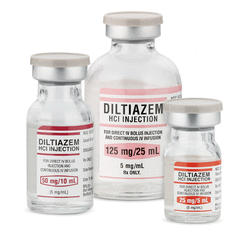Pharmacology definition - Diltiazem

Diltiazem
Diltiazem is part of the class IV anti arrhythmic agents. Verapamil is also part of the class IV anti arrhythmic agent. Verapamil and diltiazem may be used in treating patient with supraventricular tachycardia, atrial fibrillation, angina and hypertension. The common side effects are heart block and hypotension.
Class IV anti arrhythmic agent will act by binding and blocking the voltage gated calcium channels of smooth muscle and cardiac muscle. Class IV anti arhythmic agent may block the flow of calcium into the AV nodal cells. Class IV anti arrhythmic agent may slow the phase 4 spontaneous depolarization of the cell which delayed the activation and contraction of the cardiac and smooth muscle. This will manifested as prolongation of the PR interval. Class IV anti arrhythmic agent may delay the repolarization of the myocyte and prolonged the refractory period of mycoyte. As a result, there will be a reduction in the frequency of the contraction of the cell.
Diltiazem is part of the class IV anti arrhythmic agents. Verapamil is also part of the class IV anti arrhythmic agent. Verapamil and diltiazem may be used in treating patient with supraventricular tachycardia, atrial fibrillation, angina and hypertension. The common side effects are heart block and hypotension.
Class IV anti arrhythmic agent will act by binding and blocking the voltage gated calcium channels of smooth muscle and cardiac muscle. Class IV anti arhythmic agent may block the flow of calcium into the AV nodal cells. Class IV anti arrhythmic agent may slow the phase 4 spontaneous depolarization of the cell which delayed the activation and contraction of the cardiac and smooth muscle. This will manifested as prolongation of the PR interval. Class IV anti arrhythmic agent may delay the repolarization of the myocyte and prolonged the refractory period of mycoyte. As a result, there will be a reduction in the frequency of the contraction of the cell.
